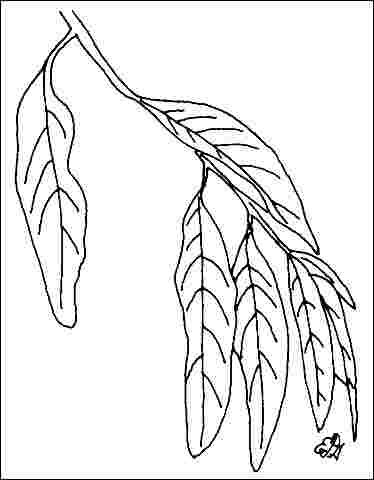Introduction
Russian olive grows in an open, somewhat irregular globe shape 15 to 20 feet tall and wide (occasionally larger) and has silvery gray-colored foliage. It has a rapid growth rate when young becoming moderate with age. Shaping and training the leader and major branches is needed to develop a well-formed tree.

Credit: Ed Gilman, UF/IFAS
General Information
Scientific name: Elaeagnus angustifolia
Pronunciation: eel-ee-AG-nus an-gus-tih-FOLE-ee-uh
Common name(s): Russian olive, oleaster
Family: Elaeagnaceae
USDA hardiness zones: 3A through 8B (Fig. 2)
Origin: not native to North America
Invasive potential: invasive non-native
Uses: hedge; parking lot island < 100 sq ft; parking lot island 100–200 sq ft; parking lot island > 200 sq ft; specimen; reclamation; screen; highway median
Availability: somewhat available, may have to go out of the region to find the tree

Description
Height: 15 to 20 feet
Spread: 15 to 20 feet
Crown uniformity: irregular
Crown shape: spreading, oval
Crown density: open
Growth rate: fast
Texture: fine
Foliage
Leaf arrangement: alternate (Fig. 3)
Leaf type: simple
Leaf margin: entire
Leaf shape: oblong, lanceolate
Leaf venation: pinnate
Leaf type and persistence: deciduous
Leaf blade length: less than 2 inches, 2 to 4 inches
Leaf color: silver
Fall color: no color change
Fall characteristic: not showy

Flower
Flower color: white/cream/gray
Flower characteristics: not showy
Fruit
Fruit shape: round, oval
Fruit length: less than .5 inch
Fruit covering: fleshy
Fruit color: yellow
Fruit characteristics: attracts birds; not showy; fruit/leaves not a litter problem
Trunk and Branches
Trunk/bark/branches: branches droop; not showy; typically multi-trunked; no thorns
Pruning requirement: needed for strong structure
Breakage: resistant
Current year twig color: gray
Current year twig thickness: thin
Wood specific gravity: unknown
Culture
Light requirement: full sun
Soil tolerances: sand; loam; alkaline; acidic; well-drained
Drought tolerance: high
Aerosol salt tolerance: high
Other
Roots: not a problem
Winter interest: yes
Outstanding tree: no
Ozone sensitivity: unknown
Verticillium wilt susceptibility: susceptible
Pest resistance: sensitive to pests/diseases
Use and Management
This thorny tree transplants well but susceptibility to canker diseases and verticillium wilt make it undesirable for large scale landscape plantings, particularly in the moist, eastern climate. But used as an occasional accent, the tree attracts attention due to the color of the foliage. It is commonly planted in the drier parts of the country and performs well due to drought tolerance and drier soil. It has escaped cultivation on the panhandle of Texas and Oklahoma along stream banks. Plant in the area of the landscape with the best drainage. Although often short-lived, it can add color to the landscape and can be planted due to extreme tolerance to tough sites and poor soils.
This tough tree fixes its own nitrogen and prefers a sunny location and is tolerant of alkaline soil, drought, and coastal conditions including salty soil. It probably is better suited for dry climates than the moist climate typical of the eastern United States. It is well suited to central and western Texas, even in heavy clay, but with good surface drainage.
Pests
Few insects bother elaeagnus. The most likely insect problem may be an infestation by one of the scale insects. Use horticultural oil for some control.
Diseases
Several fungi cause leaf spots on Russian olive but are not serious enough to warrant chemical control.
Several canker diseases attack the branches and trunk, particularly in the humid east. The leaves on infected branches turn brown and persist on the tree. Usually, only the branch tip is affected.
Elaeagnus is often killed by verticillium wilt in the east in wet areas or poorly drained sites. The disease causes wilting and browning of leaves on affected branches. Fertilize infected trees and prune out dead branches. The disease is usually fatal and has affected many plantings in the mid-west.